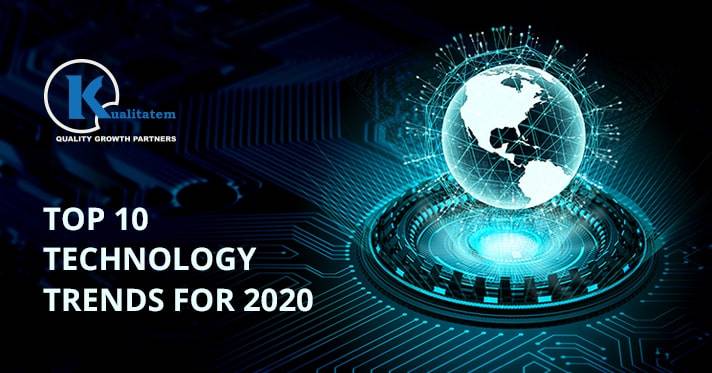Top 10 Technology Trends for 2020

- November 12, 2019
- HibaSulaiman
Gartner, Inc. has presented the top 10 technology trends for 2020 at Gartner IT Symposium/Xpo. Gartner, Inc. is the world’s leading research and advisory company that provides business leaders with insights and advice to achieve success. The purpose of this symposium was to explore the technology, insights, and trends that will shape the future of IT and businesses in 2020. More than 9,000 CIOs and IT executives attended this event in Orlando to discuss key topics including data and analytics, culture, artificial intelligence, machine learning, cyber security, and much more.
Technology is restructuring all aspects of how businesses work, and people communicate with each other. New digital trends are emerging, connecting everyone like never before. It emphasizes software testing companies to reshape their automation testing services that help in cultivating the new digital trends in testing processes.
Following are the top 10 technology trends to watch out for in 2020:
1. Hyperautomation
Hyperautomation is the combination of automation tools, machine learning (ML) and packaged software to deliver work. Gartner states that this trend started with the robotic process automation (RPA). The report adds, “RPA alone is not hyper-automation. It requires a combination of tools to help support replicating pieces of where the human is involved in a task.” Hyperautomation is the ability to loop human intervention into the process.
2. Human Augmentation
Human augmentation is a term that explains how technology can be used to augment humans both physically and cognitively. Physical augmentation changes inherent capabilities by implanting a technology element on human bodies, such as wearable devices. Whereas cognitive augmentation is concerned with accessing applications on computer systems with the emerging multi-experience interfaces.
3. Multiexperience
By multiexperience, we mean how humans are shifting from a two-dimensional screen to a much more dynamic interface. People use virtual reality (VR), augmented reality (AR) and mixed reality (MR) in the digital world. This shift in both perception and interaction will lead to multiexperience across various conversational platforms. An automation testing company ensures devising strategies and using tools to improve customer experience.
4. Democratization of Expertise
Democratization refers to wider access to technical expertise (i.e. machine learning) or business domain expertise (i.e. sales) for users. It is more about how advanced technology will be available for the end-users to explore maximum machine learning and artificial learning capabilities. Gartner expects that four key aspects of democratization will accelerate, they include:
- Data and analytics
- Development
- Design
- And Knowledge
5. Transparency and Traceability
Organizations emphasize understanding how they are managing and securing their customers’ personal data from security breaches. Transparency and traceability are two critical elements to support digital growth. It includes a range of supporting technologies, including cyber security, regulatory standards, and other advanced technologies.
6. Distributed Cloud
The cloud technology is evolving with digital transformation efforts. Though the cloud is independent the distributed cloud makes the physical location of data more important. There should be more regulation standards placed to ensure the safety of data on a distributed cloud.
7. The Empowered Edge
The empowered edge is the concept of shifting from computer power to edge devices to promote centralization. It supports reducing latency and allows for some level of autonomy on the edge devices.
8. Autonomous Things
All physical devices that use AI to automate functions performed by human beings previously are known as autonomous things. They include drones, robots, AI-powered vehicles, and appliances. Technological advancements call for more regulation permits, and autonomous things will increasingly be deployed in uncontrolled public spaces. Here, automation testing services will play an important role in reshaping AI capabilities.
9. AI Security
Till now AI is being used to breach systems and networks and strengthen cyber security simultaneously. Both, white hackers and unethical hackers are on the run. While AI and machine learning continues to be applied to create opportunities for hyper-automation. Yet they also create new challenges for security teams, as the security risks with respect to IoT devices, cloud computing, etc. in smart spaces is relatively high. Organizations need to work on increasing AI security throughout their business workflows.
10. Practical Blockchain
Why is it called practical blockchain? The reason is that we have been talking about it for a few years. There are unknown technical and management factors responsible for unsuccessful blockchain. With a more pragmatic look, we hope researchers will understand how blockchain will be successful and how it should be evolved in the future to make the most of this technology.
Gartner has defined strategic technology trends as the substantial disruptive potential that is beginning to break out of an emerging state. The afore-mentioned key trends can be useful for firms aiming to reach the top in the coming years.











